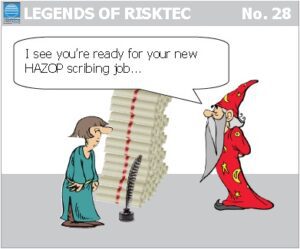Secrets of Successful HAZOP Scribing
Hazard and Operability (HAZOP) studies are one of the most commonly used hazard identification methods in the high hazard process industries. Experienced HAZOP leaders are crucial to the success of the study, bringing together their technical knowledge and team facilitation skills to ensure a comprehensive and accurate study. But the quality of the study, especially the output, is also highly dependent on the quality of the reporting, which is the work of the HAZOP scribe.

Below, we have pooled the experience of many scribes to give you some top tips for successful HAZOP recording.
1. Be prepared
As with all workshops, the success of a HAZOP depends on good planning and preparation by the facilitator and scribe. As well as obvious things like arranging a suitable venue, testing laptops and projectors, defining HAZOP nodes and guidewords, and having drawings and other technical information available, it is good practice to provide a briefing note in advance so that attendees are up to speed. Coming armed with an attendance sheet and name cards for delegates can add another touch of professionalism to proceedings.
2. Anticipate issues
It is worth considering beforehand what the main talking points might be and anticipating what further information might be needed to address any issues, provided of course this can be achieved quickly. A broader solution is to copy the entire electronic project file onto your laptop so that you’re ready for any eventuality. If it’s a follow-on HAZOP, make sure you have the previous reports in case related questions arise.
3. Manage expectations
If you’re meeting for the first time, it is a good idea to run through the recording process with the team, so that everyone knows what to expect and how information will be structured, both on the day and in the final report. Remember that some might be new to the HAZOP process or the method of recording, e.g. proprietary software. The HAZOP facilitator might choose to do this as part of the introduction or may look to the scribe. Agree beforehand who does what so that it all goes smoothly.
4. Consider pre-populating
HAZOP studies can be expensive endeavours, both in time and resources. Whilst an effective facilitator can be instrumental in speeding the process up, progress can be accelerated by pre-populating the HAZOP record with information. For example, for each node the potential causes of a hazard can be pre-loaded in readiness, and suitably tailored as you go. Developing a standard approach to hazard recording also helps because this allows a high degree of smart copying and pasting.
5. Stay focused
Being a scribe is more than speedy typing. You need the mental stamina to remain alert and engaged with the exchange between engineers, operators, process and design leads. Whilst strong coffee and a good night’s sleep can help, the key is to stay focused and interested in the subject matter, and not be concerned that every keystroke is projected on a big screen, mistakes and all. A good facilitator makes all the difference in how the day goes, but it is up to the scribe to ensure that scenarios are documented thoroughly and accurately.
6. Look ahead
After a while, a good scribe will be able to see where a discussion is leading, anticipate the outcome and start typing early. Taking the initiative as hazards become clear can serve to bring discussion to a head and promote agreement. Not only does this speed things up, but it also makes the facilitator’s job much easier.
7. Clarify and confirm
For even the most experienced scribe there will be times when an issue seems confused or ambiguous. Rather than just launching into type, it is wiser to take a moment to clarify. More generally, blind alleys can easily be avoided if you confirm your understanding of complex issues before committing to electronic ink.
8. Adapt to different styles
The more a facilitator and scribe work together, the more effective they are as a team. Each facilitator has a certain style and set of preferences, as does the client. Some studies can be high level and fast-paced, others require a more detailed, methodical approach. Many need recording using proprietary software, some may simply use a Word table or Excel worksheet. Simply recognising this fact and remaining flexible is the first step to being a great scribe.
CONCLUSION
Facilitators tend to grab the limelight of a HAZOP study. But it is the ability of the scribe to work seamlessly with the facilitator and accurately record the team’s views that also ensures the quality of the documented HAZOP.

This article first appeared in RISKworld issue 28








